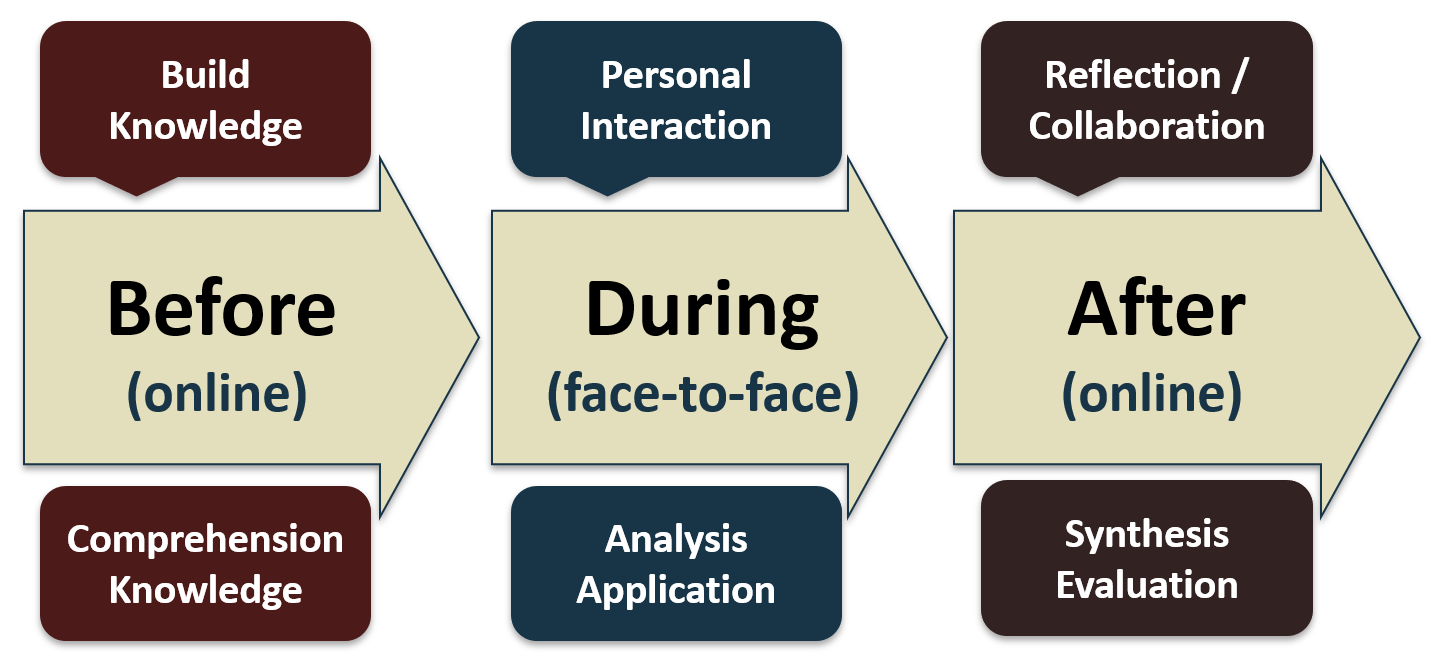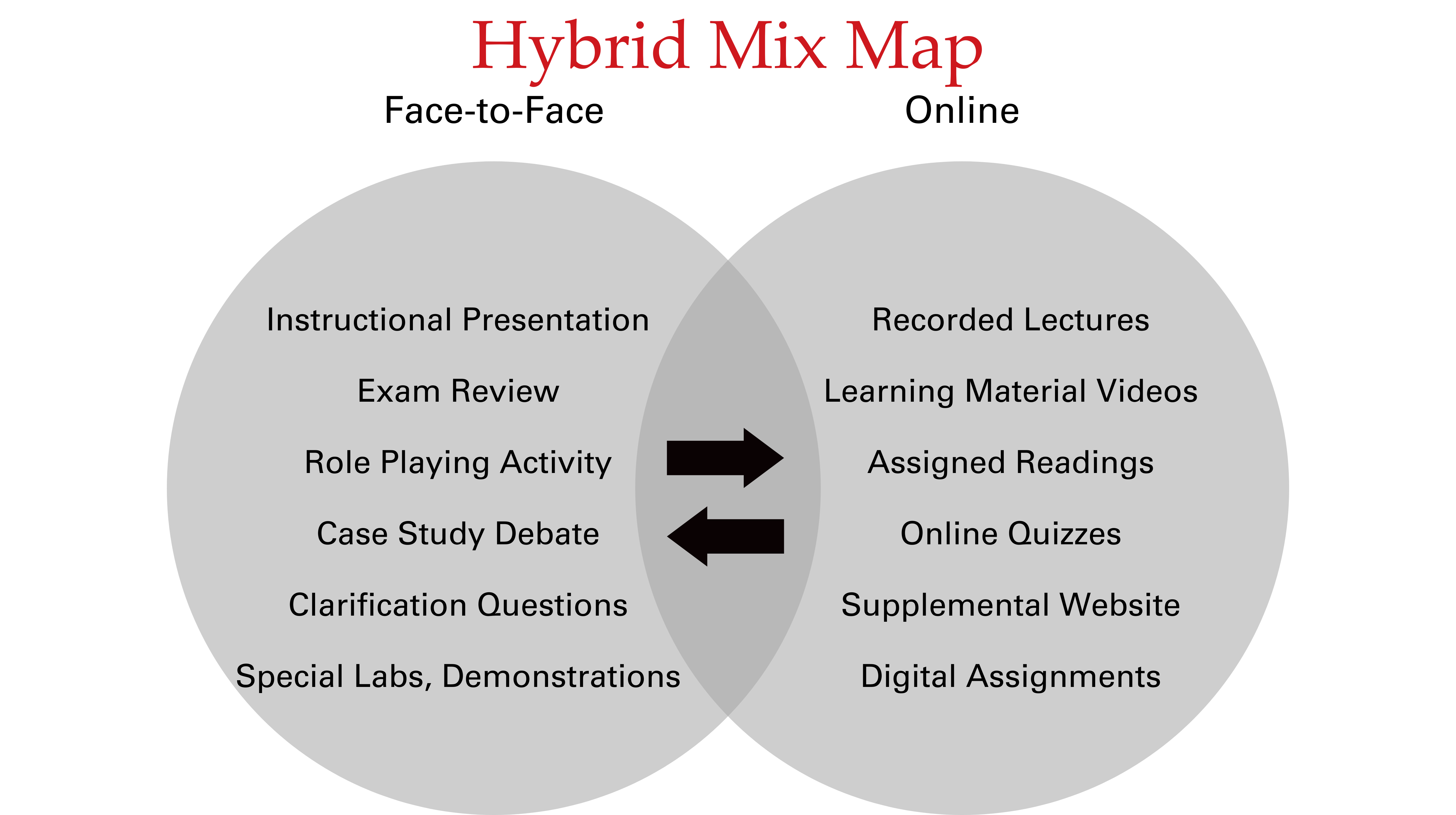Hybrid Learning
I. What is Hybrid Learning?
- UL Lafayette defines “Hybrid” as a course that is taught 50 to 99% online.
- Hybrid courses bring students together only where/when needed, allowing them to engage in a mix of synchronous (in-class) and asynchronous (anytime/anywhere) learning.
- Hybrid instructors deliver a substantial portion of their content online, using discussion forums and other electronic collaboration formats to facilitate student engagement with the content, other students, and the instructor.
Approach
- Learner-centered
- Active
- Collaborative
- Meets multiple learning styles
Instructor Role
- Facilitator
- Guides students in learning
- Provides frequent feedback with many small assessments
Student Role
- Preparation before class
- Individual or collaborative work
- More responsibility for learning
Adapted from: "Getting Started with Designing a Blended Learning Course"
II. How does it work?
Hybrid course design is a flexible blend of online and in-person learning experiences. The guiding principle is to plan instructional materials and activities around which format — face-to-face or online — suits them best. This approach can allow instructors to spend more in-class time on learning activities, collaboration, and assessment.
A well-designed hybrid course feels like a seamless and continuous learning experience, not two half classes merged together.
Learning Environment
- Class time shortened and/or used more for interactive learning activities
- Class activities partially online and partially face-to-face
In-Class Time
- Less time lecturing
- More time engaging in active learning activities
Online Time
- Online learning activities
- Online discussions and replies
- Reading & watching materials
- Collaborative writing assignments
Adapted from: "Getting Started with Designing a Blended Learning Course"
III. Benefits of Hybrid Learning
Instructor Benefits
- Less lecturing: Move passive lecture components online and use class time for application, problem-solving, and collaboration.
- Improved understanding: Enable self-paced learning so students have time to engage, re-engage, and improve understanding of course materials.
- Increased engagement: Recenter the course around students to increase engagement.
- Teaching-research balance: Gain the flexibility to engage in research and administrative responsibilities without reducing teaching load and quality of instruction.
Student Benefits
- Personalized learning: Gain the flexibility to learn at their own pace at a time that works best for them.
- Collaboration opportunities: Receive both professor and classmate facetime.
- Thoughtful engagement: Have an equal opportunity to contribute to online discussions without the anxiety and time-constraints of face-to-face conversations.
- Greater progress: Learning happens inside and outside of class.
- Enhanced retention: Proven to provide deeper and more effective learning.
In fact, the following linked study from the US Department of Education indicated that students found hybrid learning to be the most effective form of learning: “Evaluation of Evidence-Based Practices in Online Learning”.
IV. Where does learning happen?
Learning happens both inside and outside of the classroom. Hybrid course design makes the most of each venue by applying a flipped classroom approach where instructional materials are delivered online so that face-to-face time can be used more effectively for active learning and collaboration.

Source: https://youtu.be/YIb8t2PQBvQ
V. How Do You Design a Hybrid Course?
- Map out course learning objectives and outcomes.
- Use backward design principles and Bloom’s taxonomy to create assignments and assessments that support your learning objectives.
- Create activities that support your learning objectives, promote active learning, foster collaboration, and encourage the following interactions: student-content, student-student, and student-instructor.
- Design online material to flow into in-person classes and vice-versa.
- Develop module-level learning objectives.
- Identify which learning activities will occur online or onsite.

Resources
Ten questions to consider: https://uwaterloo.ca/centre-for-teaching-excellence/teaching-resources/teaching-tips/planning-courses-and-assignments/ten-questions-ask-when-designing-blended-course
Course Design Documents: Course Blueprint, Blended Course Integration Chart, Blended Learning Mix Map
